Project Risk Management: Literature Review on Culture and Attitude
VerifiedAdded on 2022/12/12
|13
|2934
|51
Report
AI Summary
This report provides a comprehensive literature review on risk management, focusing on the interplay between risk culture and risk attitude. It explores how these factors influence the outcome of risk management processes within organizations. The report delves into the impact of risk attitude on the formation of risk culture, emphasizing the need for a robust risk culture to enhance project success and organizational resilience. It identifies key components of a positive risk culture, such as leadership commitment, employee involvement, and accountability, and the importance of balancing accountability with learning from errors. The review also discusses the consequences of inadequate risk cultures, highlighting the significance of employee behavior and decision-making in relation to risk. The report emphasizes that a strong risk culture can help mitigate various risks within the organization.
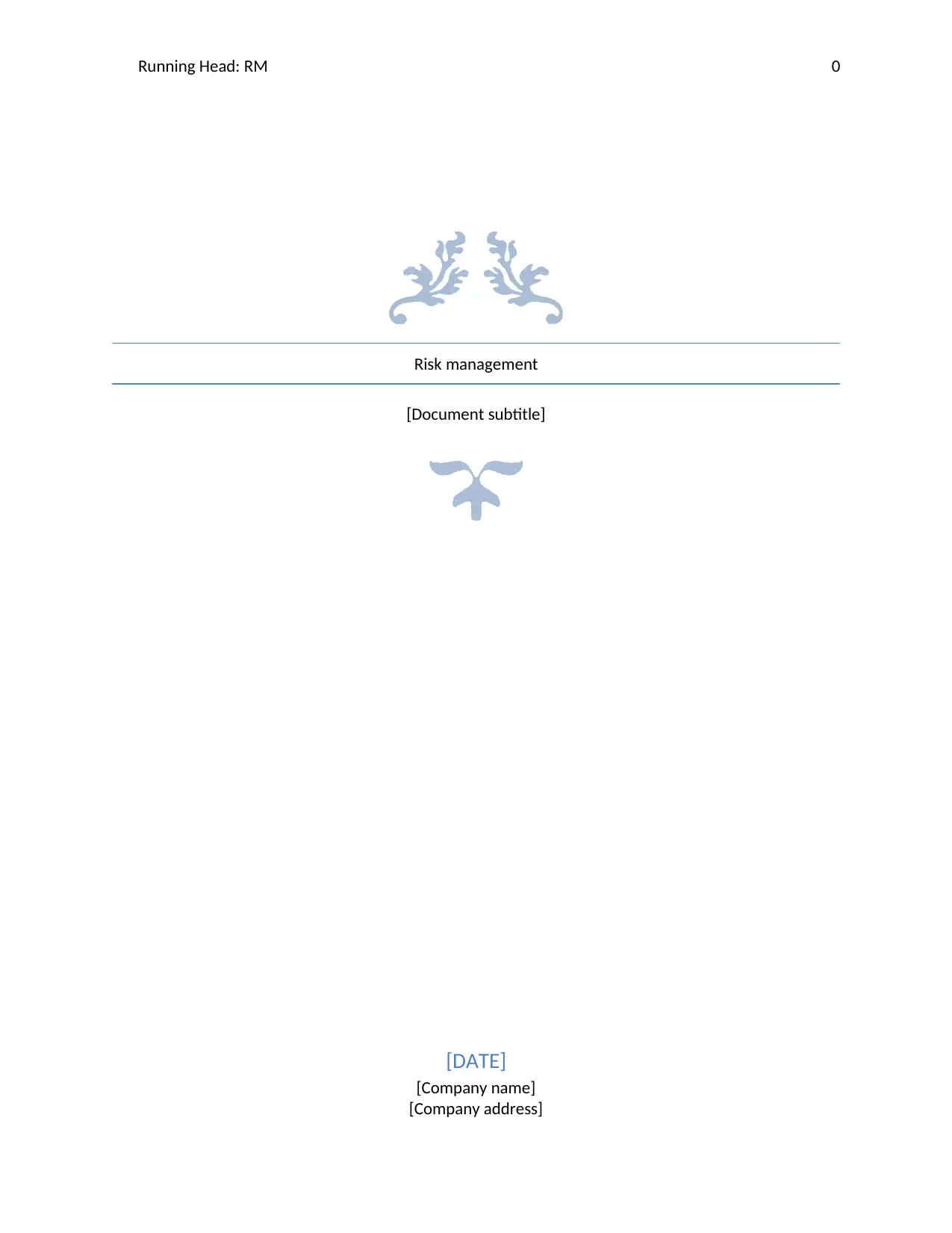
Running Head: RM 0
Risk management
[Document subtitle]
[DATE]
[Company name]
[Company address]
Risk management
[Document subtitle]
[DATE]
[Company name]
[Company address]
Paraphrase This Document
Need a fresh take? Get an instant paraphrase of this document with our AI Paraphraser
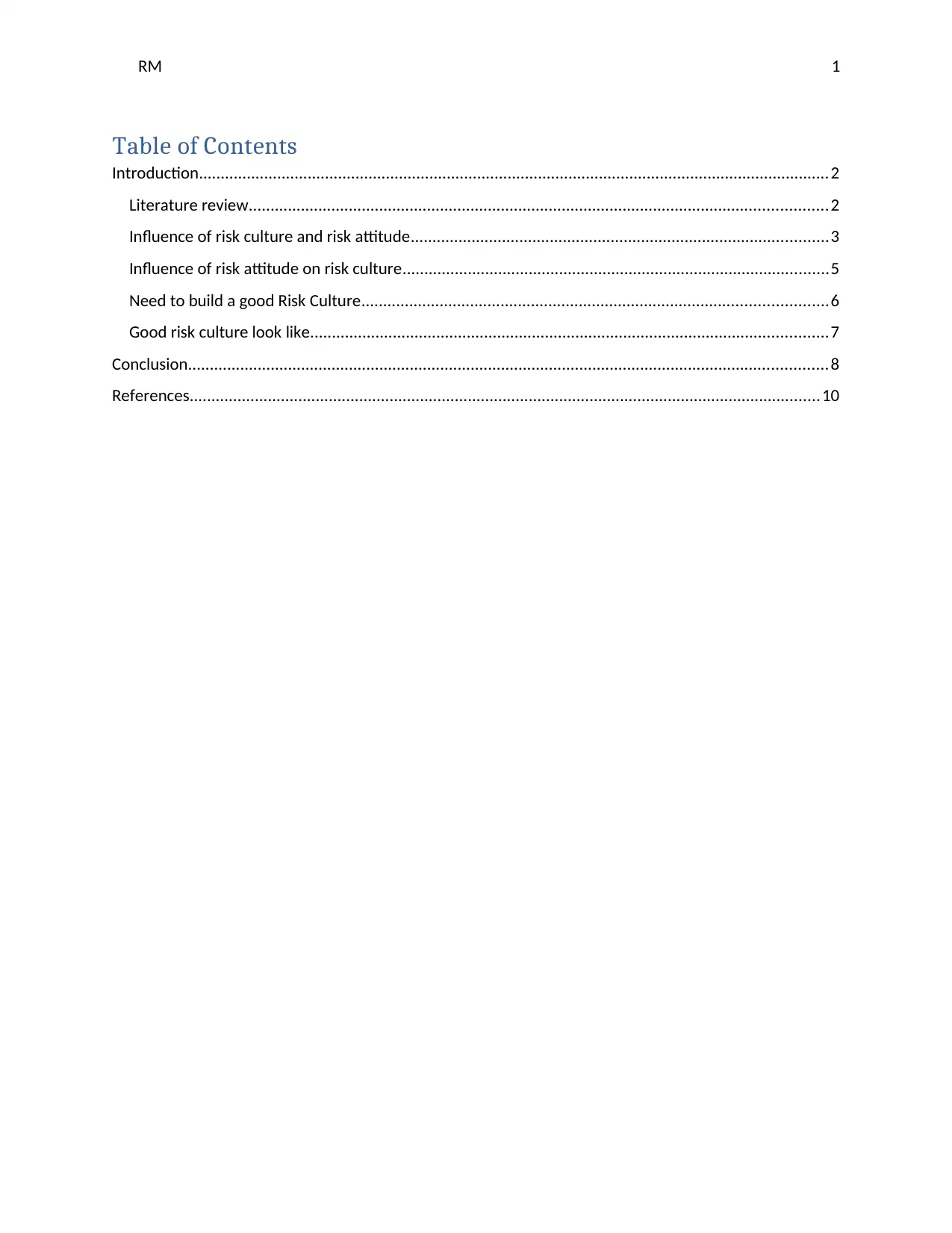
RM 1
Table of Contents
Introduction.................................................................................................................................................2
Literature review.....................................................................................................................................2
Influence of risk culture and risk attitude................................................................................................3
Influence of risk attitude on risk culture..................................................................................................5
Need to build a good Risk Culture...........................................................................................................6
Good risk culture look like.......................................................................................................................7
Conclusion...................................................................................................................................................8
References.................................................................................................................................................10
Table of Contents
Introduction.................................................................................................................................................2
Literature review.....................................................................................................................................2
Influence of risk culture and risk attitude................................................................................................3
Influence of risk attitude on risk culture..................................................................................................5
Need to build a good Risk Culture...........................................................................................................6
Good risk culture look like.......................................................................................................................7
Conclusion...................................................................................................................................................8
References.................................................................................................................................................10
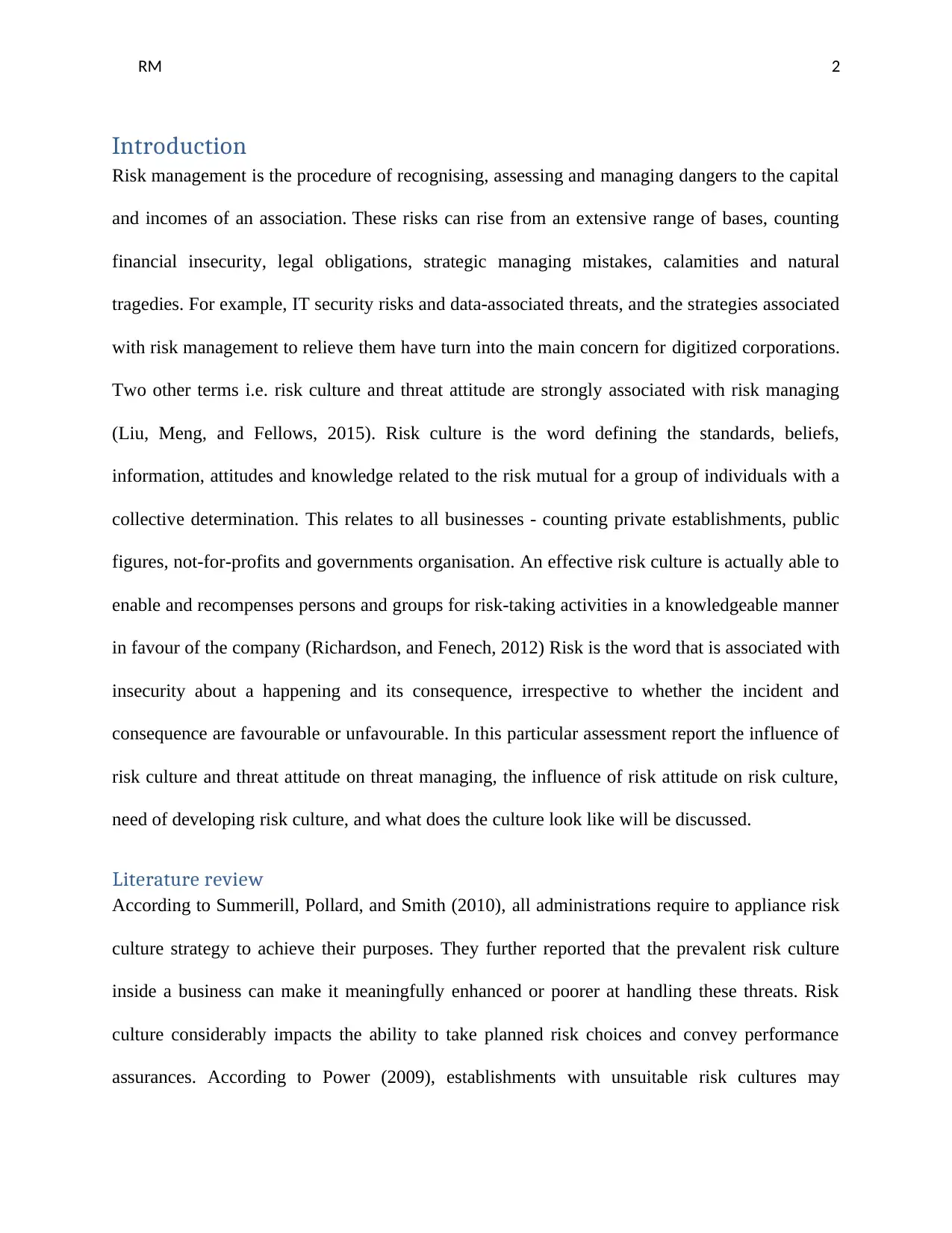
RM 2
Introduction
Risk management is the procedure of recognising, assessing and managing dangers to the capital
and incomes of an association. These risks can rise from an extensive range of bases, counting
financial insecurity, legal obligations, strategic managing mistakes, calamities and natural
tragedies. For example, IT security risks and data-associated threats, and the strategies associated
with risk management to relieve them have turn into the main concern for digitized corporations.
Two other terms i.e. risk culture and threat attitude are strongly associated with risk managing
(Liu, Meng, and Fellows, 2015). Risk culture is the word defining the standards, beliefs,
information, attitudes and knowledge related to the risk mutual for a group of individuals with a
collective determination. This relates to all businesses - counting private establishments, public
figures, not-for-profits and governments organisation. An effective risk culture is actually able to
enable and recompenses persons and groups for risk-taking activities in a knowledgeable manner
in favour of the company (Richardson, and Fenech, 2012) Risk is the word that is associated with
insecurity about a happening and its consequence, irrespective to whether the incident and
consequence are favourable or unfavourable. In this particular assessment report the influence of
risk culture and threat attitude on threat managing, the influence of risk attitude on risk culture,
need of developing risk culture, and what does the culture look like will be discussed.
Literature review
According to Summerill, Pollard, and Smith (2010), all administrations require to appliance risk
culture strategy to achieve their purposes. They further reported that the prevalent risk culture
inside a business can make it meaningfully enhanced or poorer at handling these threats. Risk
culture considerably impacts the ability to take planned risk choices and convey performance
assurances. According to Power (2009), establishments with unsuitable risk cultures may
Introduction
Risk management is the procedure of recognising, assessing and managing dangers to the capital
and incomes of an association. These risks can rise from an extensive range of bases, counting
financial insecurity, legal obligations, strategic managing mistakes, calamities and natural
tragedies. For example, IT security risks and data-associated threats, and the strategies associated
with risk management to relieve them have turn into the main concern for digitized corporations.
Two other terms i.e. risk culture and threat attitude are strongly associated with risk managing
(Liu, Meng, and Fellows, 2015). Risk culture is the word defining the standards, beliefs,
information, attitudes and knowledge related to the risk mutual for a group of individuals with a
collective determination. This relates to all businesses - counting private establishments, public
figures, not-for-profits and governments organisation. An effective risk culture is actually able to
enable and recompenses persons and groups for risk-taking activities in a knowledgeable manner
in favour of the company (Richardson, and Fenech, 2012) Risk is the word that is associated with
insecurity about a happening and its consequence, irrespective to whether the incident and
consequence are favourable or unfavourable. In this particular assessment report the influence of
risk culture and threat attitude on threat managing, the influence of risk attitude on risk culture,
need of developing risk culture, and what does the culture look like will be discussed.
Literature review
According to Summerill, Pollard, and Smith (2010), all administrations require to appliance risk
culture strategy to achieve their purposes. They further reported that the prevalent risk culture
inside a business can make it meaningfully enhanced or poorer at handling these threats. Risk
culture considerably impacts the ability to take planned risk choices and convey performance
assurances. According to Power (2009), establishments with unsuitable risk cultures may
⊘ This is a preview!⊘
Do you want full access?
Subscribe today to unlock all pages.

Trusted by 1+ million students worldwide
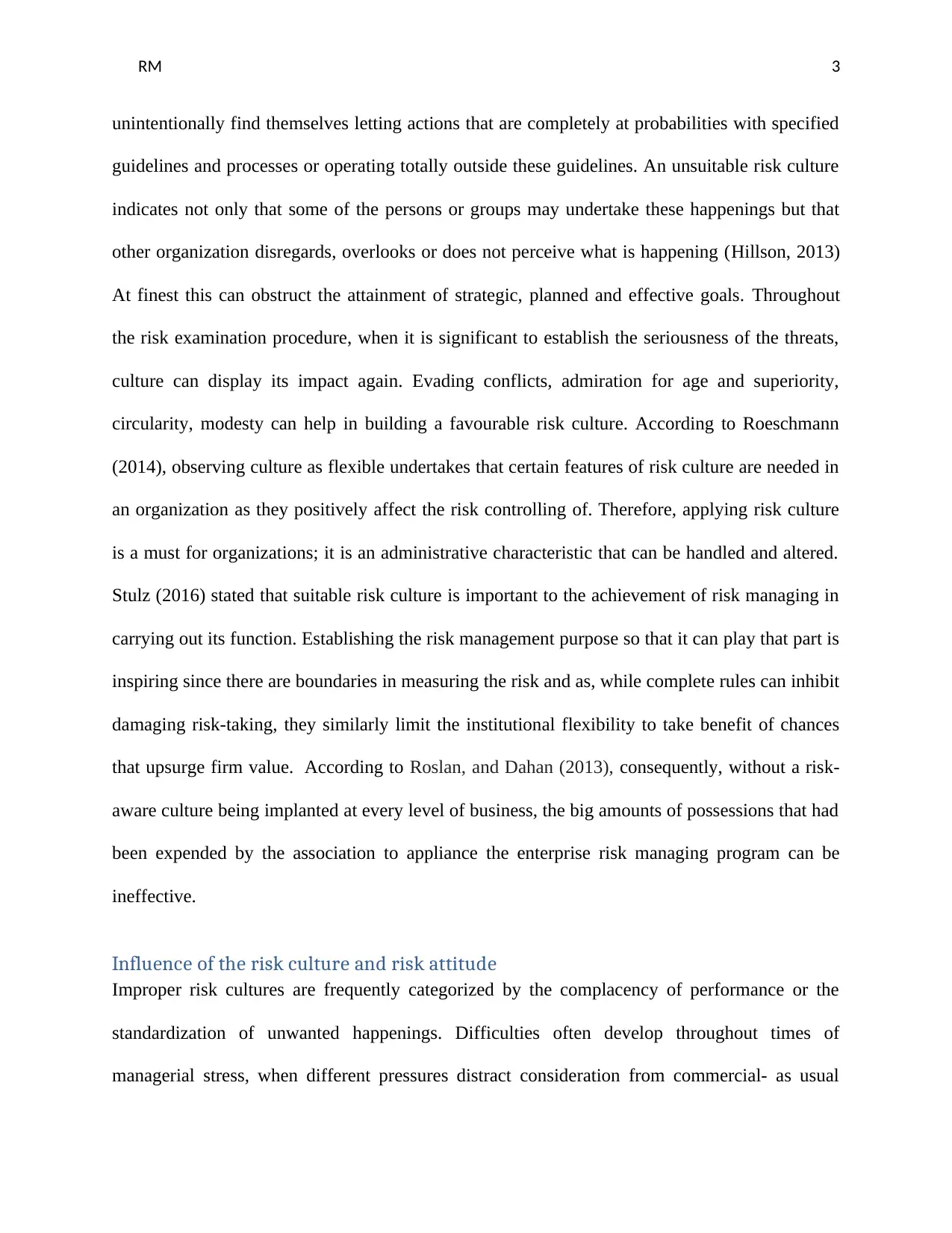
RM 3
unintentionally find themselves letting actions that are completely at probabilities with specified
guidelines and processes or operating totally outside these guidelines. An unsuitable risk culture
indicates not only that some of the persons or groups may undertake these happenings but that
other organization disregards, overlooks or does not perceive what is happening (Hillson, 2013)
At finest this can obstruct the attainment of strategic, planned and effective goals. Throughout
the risk examination procedure, when it is significant to establish the seriousness of the threats,
culture can display its impact again. Evading conflicts, admiration for age and superiority,
circularity, modesty can help in building a favourable risk culture. According to Roeschmann
(2014), observing culture as flexible undertakes that certain features of risk culture are needed in
an organization as they positively affect the risk controlling of. Therefore, applying risk culture
is a must for organizations; it is an administrative characteristic that can be handled and altered.
Stulz (2016) stated that suitable risk culture is important to the achievement of risk managing in
carrying out its function. Establishing the risk management purpose so that it can play that part is
inspiring since there are boundaries in measuring the risk and as, while complete rules can inhibit
damaging risk-taking, they similarly limit the institutional flexibility to take benefit of chances
that upsurge firm value. According to Roslan, and Dahan (2013), consequently, without a risk-
aware culture being implanted at every level of business, the big amounts of possessions that had
been expended by the association to appliance the enterprise risk managing program can be
ineffective.
Influence of the risk culture and risk attitude
Improper risk cultures are frequently categorized by the complacency of performance or the
standardization of unwanted happenings. Difficulties often develop throughout times of
managerial stress, when different pressures distract consideration from commercial- as usual
unintentionally find themselves letting actions that are completely at probabilities with specified
guidelines and processes or operating totally outside these guidelines. An unsuitable risk culture
indicates not only that some of the persons or groups may undertake these happenings but that
other organization disregards, overlooks or does not perceive what is happening (Hillson, 2013)
At finest this can obstruct the attainment of strategic, planned and effective goals. Throughout
the risk examination procedure, when it is significant to establish the seriousness of the threats,
culture can display its impact again. Evading conflicts, admiration for age and superiority,
circularity, modesty can help in building a favourable risk culture. According to Roeschmann
(2014), observing culture as flexible undertakes that certain features of risk culture are needed in
an organization as they positively affect the risk controlling of. Therefore, applying risk culture
is a must for organizations; it is an administrative characteristic that can be handled and altered.
Stulz (2016) stated that suitable risk culture is important to the achievement of risk managing in
carrying out its function. Establishing the risk management purpose so that it can play that part is
inspiring since there are boundaries in measuring the risk and as, while complete rules can inhibit
damaging risk-taking, they similarly limit the institutional flexibility to take benefit of chances
that upsurge firm value. According to Roslan, and Dahan (2013), consequently, without a risk-
aware culture being implanted at every level of business, the big amounts of possessions that had
been expended by the association to appliance the enterprise risk managing program can be
ineffective.
Influence of the risk culture and risk attitude
Improper risk cultures are frequently categorized by the complacency of performance or the
standardization of unwanted happenings. Difficulties often develop throughout times of
managerial stress, when different pressures distract consideration from commercial- as usual
Paraphrase This Document
Need a fresh take? Get an instant paraphrase of this document with our AI Paraphraser
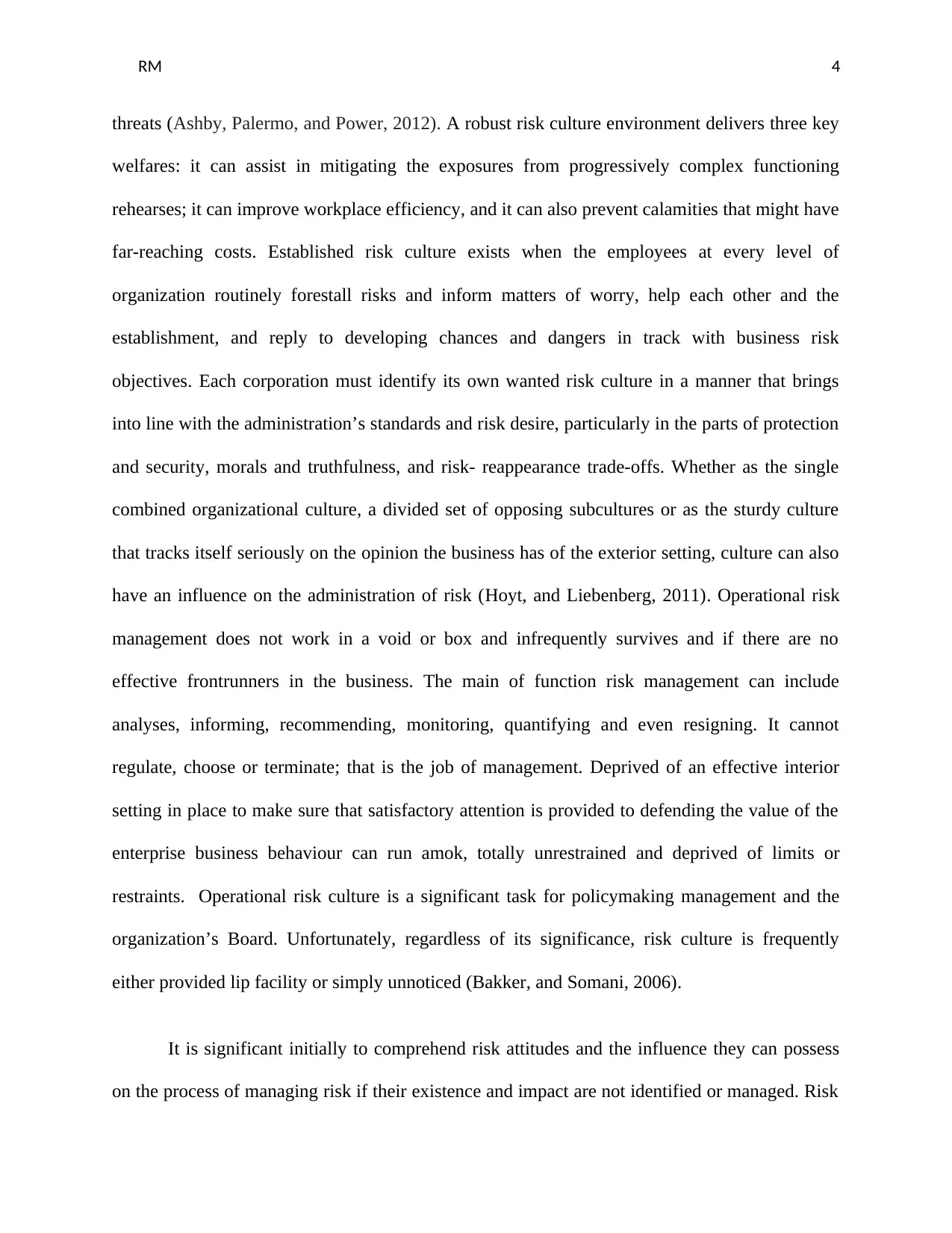
RM 4
threats (Ashby, Palermo, and Power, 2012). A robust risk culture environment delivers three key
welfares: it can assist in mitigating the exposures from progressively complex functioning
rehearses; it can improve workplace efficiency, and it can also prevent calamities that might have
far-reaching costs. Established risk culture exists when the employees at every level of
organization routinely forestall risks and inform matters of worry, help each other and the
establishment, and reply to developing chances and dangers in track with business risk
objectives. Each corporation must identify its own wanted risk culture in a manner that brings
into line with the administration’s standards and risk desire, particularly in the parts of protection
and security, morals and truthfulness, and risk- reappearance trade-offs. Whether as the single
combined organizational culture, a divided set of opposing subcultures or as the sturdy culture
that tracks itself seriously on the opinion the business has of the exterior setting, culture can also
have an influence on the administration of risk (Hoyt, and Liebenberg, 2011). Operational risk
management does not work in a void or box and infrequently survives and if there are no
effective frontrunners in the business. The main of function risk management can include
analyses, informing, recommending, monitoring, quantifying and even resigning. It cannot
regulate, choose or terminate; that is the job of management. Deprived of an effective interior
setting in place to make sure that satisfactory attention is provided to defending the value of the
enterprise business behaviour can run amok, totally unrestrained and deprived of limits or
restraints. Operational risk culture is a significant task for policymaking management and the
organization’s Board. Unfortunately, regardless of its significance, risk culture is frequently
either provided lip facility or simply unnoticed (Bakker, and Somani, 2006).
It is significant initially to comprehend risk attitudes and the influence they can possess
on the process of managing risk if their existence and impact are not identified or managed. Risk
threats (Ashby, Palermo, and Power, 2012). A robust risk culture environment delivers three key
welfares: it can assist in mitigating the exposures from progressively complex functioning
rehearses; it can improve workplace efficiency, and it can also prevent calamities that might have
far-reaching costs. Established risk culture exists when the employees at every level of
organization routinely forestall risks and inform matters of worry, help each other and the
establishment, and reply to developing chances and dangers in track with business risk
objectives. Each corporation must identify its own wanted risk culture in a manner that brings
into line with the administration’s standards and risk desire, particularly in the parts of protection
and security, morals and truthfulness, and risk- reappearance trade-offs. Whether as the single
combined organizational culture, a divided set of opposing subcultures or as the sturdy culture
that tracks itself seriously on the opinion the business has of the exterior setting, culture can also
have an influence on the administration of risk (Hoyt, and Liebenberg, 2011). Operational risk
management does not work in a void or box and infrequently survives and if there are no
effective frontrunners in the business. The main of function risk management can include
analyses, informing, recommending, monitoring, quantifying and even resigning. It cannot
regulate, choose or terminate; that is the job of management. Deprived of an effective interior
setting in place to make sure that satisfactory attention is provided to defending the value of the
enterprise business behaviour can run amok, totally unrestrained and deprived of limits or
restraints. Operational risk culture is a significant task for policymaking management and the
organization’s Board. Unfortunately, regardless of its significance, risk culture is frequently
either provided lip facility or simply unnoticed (Bakker, and Somani, 2006).
It is significant initially to comprehend risk attitudes and the influence they can possess
on the process of managing risk if their existence and impact are not identified or managed. Risk
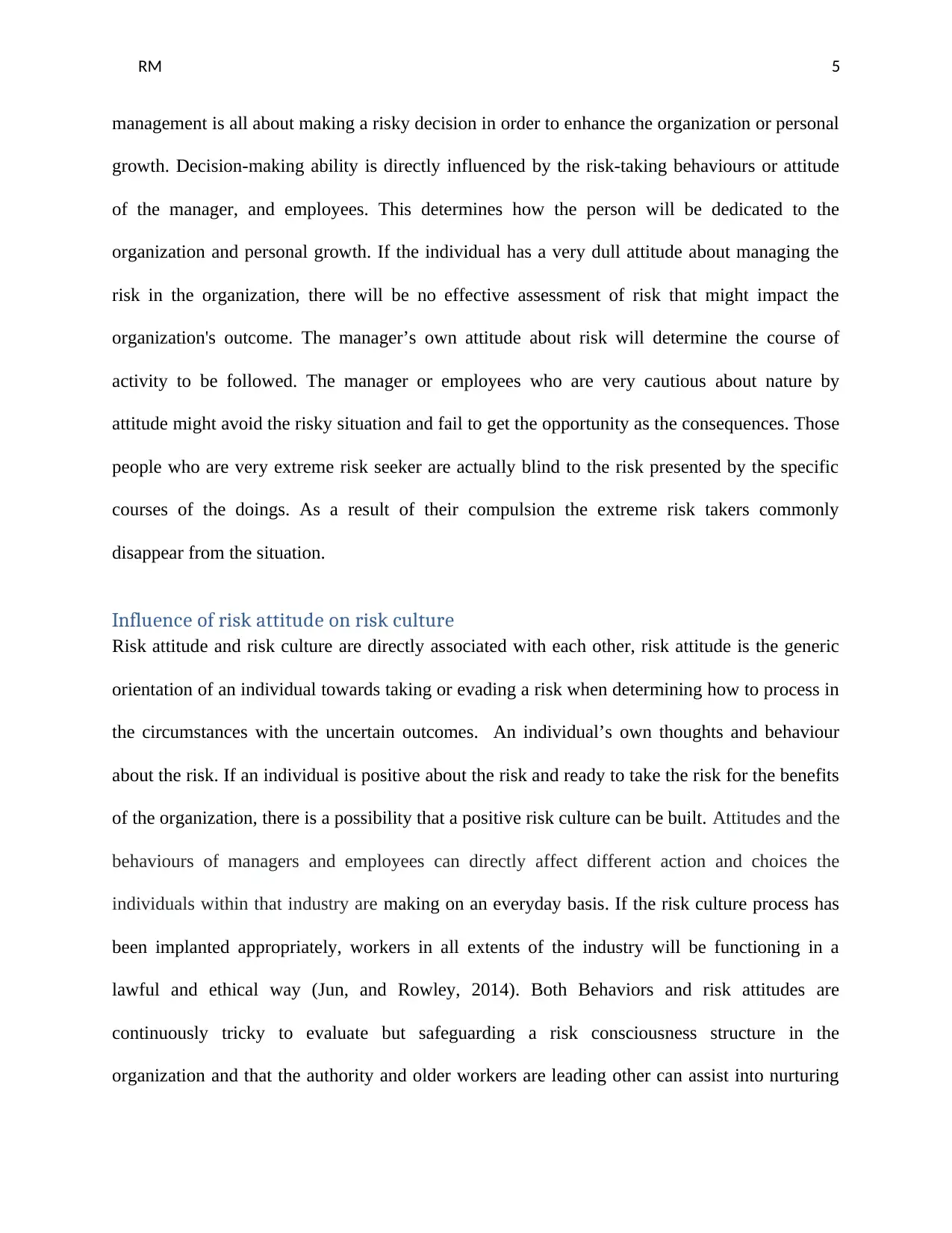
RM 5
management is all about making a risky decision in order to enhance the organization or personal
growth. Decision-making ability is directly influenced by the risk-taking behaviours or attitude
of the manager, and employees. This determines how the person will be dedicated to the
organization and personal growth. If the individual has a very dull attitude about managing the
risk in the organization, there will be no effective assessment of risk that might impact the
organization's outcome. The manager’s own attitude about risk will determine the course of
activity to be followed. The manager or employees who are very cautious about nature by
attitude might avoid the risky situation and fail to get the opportunity as the consequences. Those
people who are very extreme risk seeker are actually blind to the risk presented by the specific
courses of the doings. As a result of their compulsion the extreme risk takers commonly
disappear from the situation.
Influence of risk attitude on risk culture
Risk attitude and risk culture are directly associated with each other, risk attitude is the generic
orientation of an individual towards taking or evading a risk when determining how to process in
the circumstances with the uncertain outcomes. An individual’s own thoughts and behaviour
about the risk. If an individual is positive about the risk and ready to take the risk for the benefits
of the organization, there is a possibility that a positive risk culture can be built. Attitudes and the
behaviours of managers and employees can directly affect different action and choices the
individuals within that industry are making on an everyday basis. If the risk culture process has
been implanted appropriately, workers in all extents of the industry will be functioning in a
lawful and ethical way (Jun, and Rowley, 2014). Both Behaviors and risk attitudes are
continuously tricky to evaluate but safeguarding a risk consciousness structure in the
organization and that the authority and older workers are leading other can assist into nurturing
management is all about making a risky decision in order to enhance the organization or personal
growth. Decision-making ability is directly influenced by the risk-taking behaviours or attitude
of the manager, and employees. This determines how the person will be dedicated to the
organization and personal growth. If the individual has a very dull attitude about managing the
risk in the organization, there will be no effective assessment of risk that might impact the
organization's outcome. The manager’s own attitude about risk will determine the course of
activity to be followed. The manager or employees who are very cautious about nature by
attitude might avoid the risky situation and fail to get the opportunity as the consequences. Those
people who are very extreme risk seeker are actually blind to the risk presented by the specific
courses of the doings. As a result of their compulsion the extreme risk takers commonly
disappear from the situation.
Influence of risk attitude on risk culture
Risk attitude and risk culture are directly associated with each other, risk attitude is the generic
orientation of an individual towards taking or evading a risk when determining how to process in
the circumstances with the uncertain outcomes. An individual’s own thoughts and behaviour
about the risk. If an individual is positive about the risk and ready to take the risk for the benefits
of the organization, there is a possibility that a positive risk culture can be built. Attitudes and the
behaviours of managers and employees can directly affect different action and choices the
individuals within that industry are making on an everyday basis. If the risk culture process has
been implanted appropriately, workers in all extents of the industry will be functioning in a
lawful and ethical way (Jun, and Rowley, 2014). Both Behaviors and risk attitudes are
continuously tricky to evaluate but safeguarding a risk consciousness structure in the
organization and that the authority and older workers are leading other can assist into nurturing
⊘ This is a preview!⊘
Do you want full access?
Subscribe today to unlock all pages.

Trusted by 1+ million students worldwide
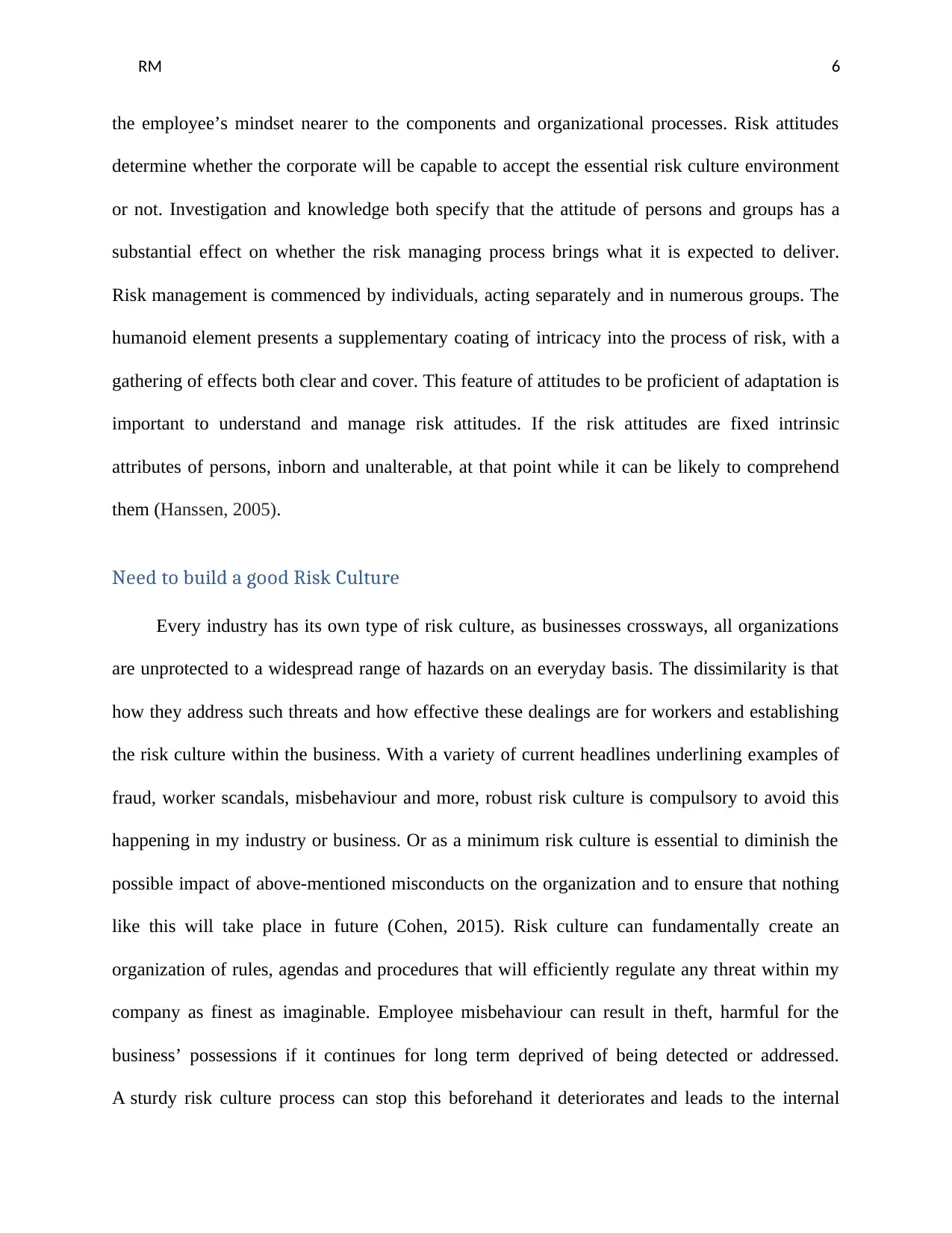
RM 6
the employee’s mindset nearer to the components and organizational processes. Risk attitudes
determine whether the corporate will be capable to accept the essential risk culture environment
or not. Investigation and knowledge both specify that the attitude of persons and groups has a
substantial effect on whether the risk managing process brings what it is expected to deliver.
Risk management is commenced by individuals, acting separately and in numerous groups. The
humanoid element presents a supplementary coating of intricacy into the process of risk, with a
gathering of effects both clear and cover. This feature of attitudes to be proficient of adaptation is
important to understand and manage risk attitudes. If the risk attitudes are fixed intrinsic
attributes of persons, inborn and unalterable, at that point while it can be likely to comprehend
them (Hanssen, 2005).
Need to build a good Risk Culture
Every industry has its own type of risk culture, as businesses crossways, all organizations
are unprotected to a widespread range of hazards on an everyday basis. The dissimilarity is that
how they address such threats and how effective these dealings are for workers and establishing
the risk culture within the business. With a variety of current headlines underlining examples of
fraud, worker scandals, misbehaviour and more, robust risk culture is compulsory to avoid this
happening in my industry or business. Or as a minimum risk culture is essential to diminish the
possible impact of above-mentioned misconducts on the organization and to ensure that nothing
like this will take place in future (Cohen, 2015). Risk culture can fundamentally create an
organization of rules, agendas and procedures that will efficiently regulate any threat within my
company as finest as imaginable. Employee misbehaviour can result in theft, harmful for the
business’ possessions if it continues for long term deprived of being detected or addressed.
A sturdy risk culture process can stop this beforehand it deteriorates and leads to the internal
the employee’s mindset nearer to the components and organizational processes. Risk attitudes
determine whether the corporate will be capable to accept the essential risk culture environment
or not. Investigation and knowledge both specify that the attitude of persons and groups has a
substantial effect on whether the risk managing process brings what it is expected to deliver.
Risk management is commenced by individuals, acting separately and in numerous groups. The
humanoid element presents a supplementary coating of intricacy into the process of risk, with a
gathering of effects both clear and cover. This feature of attitudes to be proficient of adaptation is
important to understand and manage risk attitudes. If the risk attitudes are fixed intrinsic
attributes of persons, inborn and unalterable, at that point while it can be likely to comprehend
them (Hanssen, 2005).
Need to build a good Risk Culture
Every industry has its own type of risk culture, as businesses crossways, all organizations
are unprotected to a widespread range of hazards on an everyday basis. The dissimilarity is that
how they address such threats and how effective these dealings are for workers and establishing
the risk culture within the business. With a variety of current headlines underlining examples of
fraud, worker scandals, misbehaviour and more, robust risk culture is compulsory to avoid this
happening in my industry or business. Or as a minimum risk culture is essential to diminish the
possible impact of above-mentioned misconducts on the organization and to ensure that nothing
like this will take place in future (Cohen, 2015). Risk culture can fundamentally create an
organization of rules, agendas and procedures that will efficiently regulate any threat within my
company as finest as imaginable. Employee misbehaviour can result in theft, harmful for the
business’ possessions if it continues for long term deprived of being detected or addressed.
A sturdy risk culture process can stop this beforehand it deteriorates and leads to the internal
Paraphrase This Document
Need a fresh take? Get an instant paraphrase of this document with our AI Paraphraser
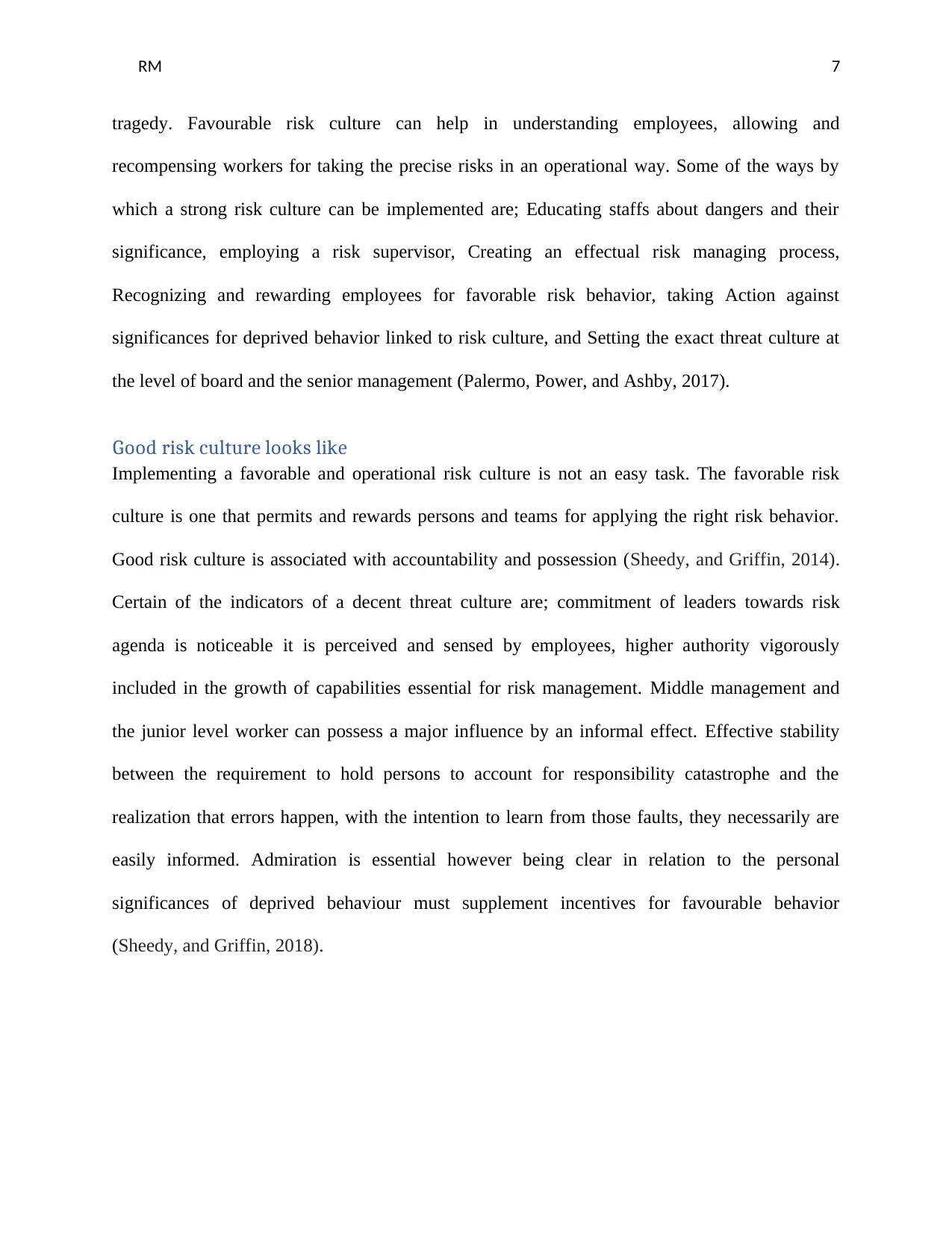
RM 7
tragedy. Favourable risk culture can help in understanding employees, allowing and
recompensing workers for taking the precise risks in an operational way. Some of the ways by
which a strong risk culture can be implemented are; Educating staffs about dangers and their
significance, employing a risk supervisor, Creating an effectual risk managing process,
Recognizing and rewarding employees for favorable risk behavior, taking Action against
significances for deprived behavior linked to risk culture, and Setting the exact threat culture at
the level of board and the senior management (Palermo, Power, and Ashby, 2017).
Good risk culture looks like
Implementing a favorable and operational risk culture is not an easy task. The favorable risk
culture is one that permits and rewards persons and teams for applying the right risk behavior.
Good risk culture is associated with accountability and possession (Sheedy, and Griffin, 2014).
Certain of the indicators of a decent threat culture are; commitment of leaders towards risk
agenda is noticeable it is perceived and sensed by employees, higher authority vigorously
included in the growth of capabilities essential for risk management. Middle management and
the junior level worker can possess a major influence by an informal effect. Effective stability
between the requirement to hold persons to account for responsibility catastrophe and the
realization that errors happen, with the intention to learn from those faults, they necessarily are
easily informed. Admiration is essential however being clear in relation to the personal
significances of deprived behaviour must supplement incentives for favourable behavior
(Sheedy, and Griffin, 2018).
tragedy. Favourable risk culture can help in understanding employees, allowing and
recompensing workers for taking the precise risks in an operational way. Some of the ways by
which a strong risk culture can be implemented are; Educating staffs about dangers and their
significance, employing a risk supervisor, Creating an effectual risk managing process,
Recognizing and rewarding employees for favorable risk behavior, taking Action against
significances for deprived behavior linked to risk culture, and Setting the exact threat culture at
the level of board and the senior management (Palermo, Power, and Ashby, 2017).
Good risk culture looks like
Implementing a favorable and operational risk culture is not an easy task. The favorable risk
culture is one that permits and rewards persons and teams for applying the right risk behavior.
Good risk culture is associated with accountability and possession (Sheedy, and Griffin, 2014).
Certain of the indicators of a decent threat culture are; commitment of leaders towards risk
agenda is noticeable it is perceived and sensed by employees, higher authority vigorously
included in the growth of capabilities essential for risk management. Middle management and
the junior level worker can possess a major influence by an informal effect. Effective stability
between the requirement to hold persons to account for responsibility catastrophe and the
realization that errors happen, with the intention to learn from those faults, they necessarily are
easily informed. Admiration is essential however being clear in relation to the personal
significances of deprived behaviour must supplement incentives for favourable behavior
(Sheedy, and Griffin, 2018).
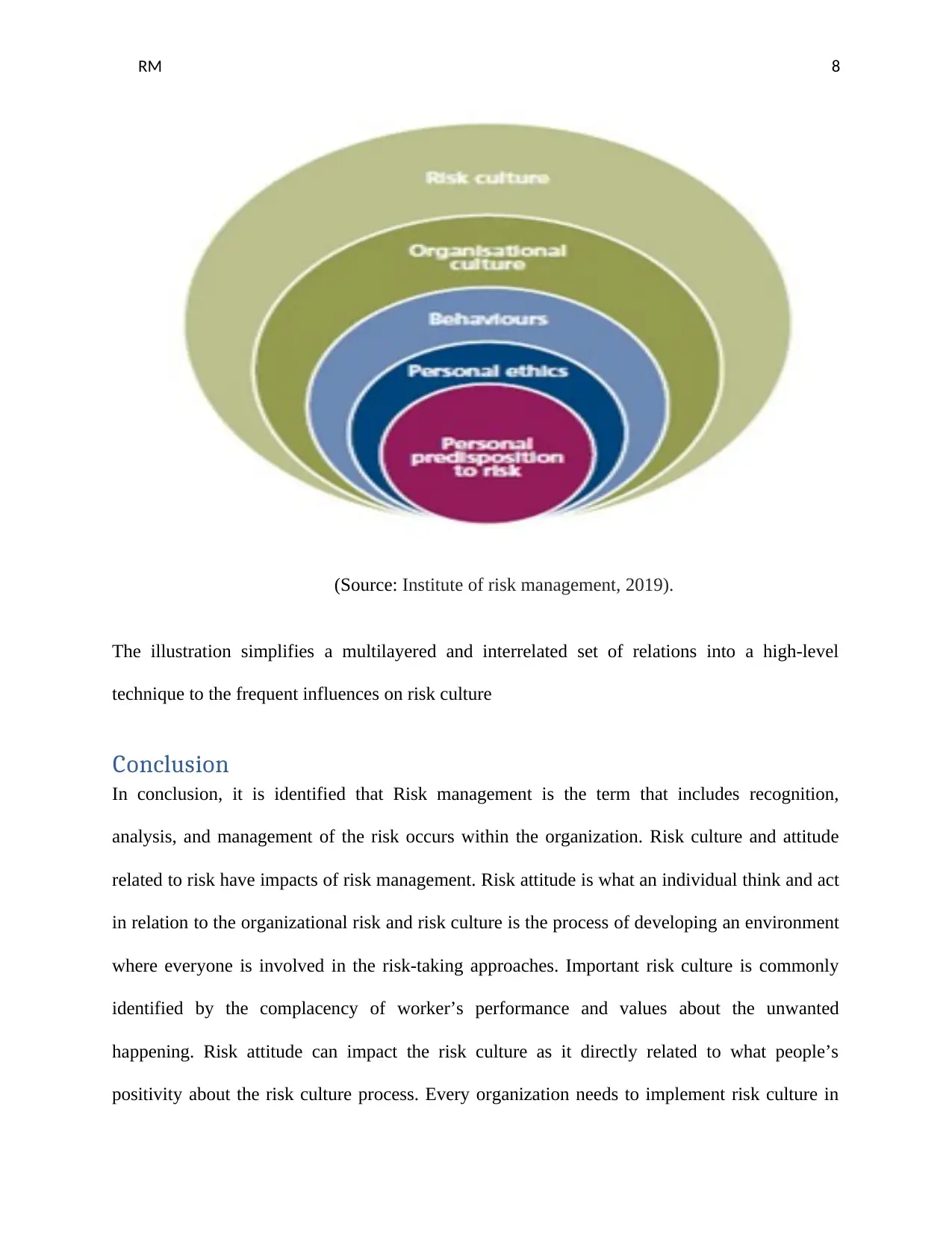
RM 8
(Source: Institute of risk management, 2019).
The illustration simplifies a multilayered and interrelated set of relations into a high-level
technique to the frequent influences on risk culture
Conclusion
In conclusion, it is identified that Risk management is the term that includes recognition,
analysis, and management of the risk occurs within the organization. Risk culture and attitude
related to risk have impacts of risk management. Risk attitude is what an individual think and act
in relation to the organizational risk and risk culture is the process of developing an environment
where everyone is involved in the risk-taking approaches. Important risk culture is commonly
identified by the complacency of worker’s performance and values about the unwanted
happening. Risk attitude can impact the risk culture as it directly related to what people’s
positivity about the risk culture process. Every organization needs to implement risk culture in
(Source: Institute of risk management, 2019).
The illustration simplifies a multilayered and interrelated set of relations into a high-level
technique to the frequent influences on risk culture
Conclusion
In conclusion, it is identified that Risk management is the term that includes recognition,
analysis, and management of the risk occurs within the organization. Risk culture and attitude
related to risk have impacts of risk management. Risk attitude is what an individual think and act
in relation to the organizational risk and risk culture is the process of developing an environment
where everyone is involved in the risk-taking approaches. Important risk culture is commonly
identified by the complacency of worker’s performance and values about the unwanted
happening. Risk attitude can impact the risk culture as it directly related to what people’s
positivity about the risk culture process. Every organization needs to implement risk culture in
⊘ This is a preview!⊘
Do you want full access?
Subscribe today to unlock all pages.

Trusted by 1+ million students worldwide
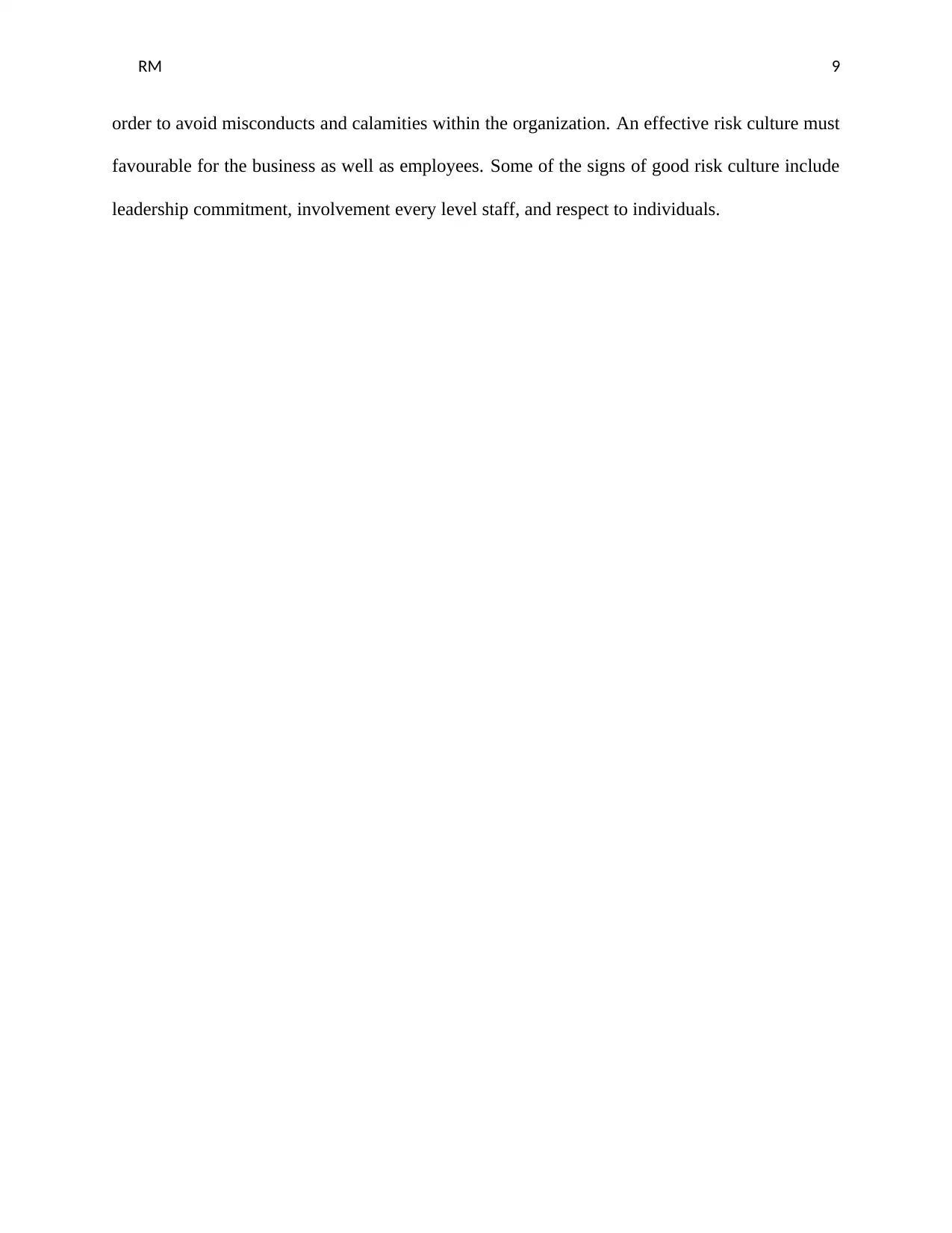
RM 9
order to avoid misconducts and calamities within the organization. An effective risk culture must
favourable for the business as well as employees. Some of the signs of good risk culture include
leadership commitment, involvement every level staff, and respect to individuals.
order to avoid misconducts and calamities within the organization. An effective risk culture must
favourable for the business as well as employees. Some of the signs of good risk culture include
leadership commitment, involvement every level staff, and respect to individuals.
Paraphrase This Document
Need a fresh take? Get an instant paraphrase of this document with our AI Paraphraser
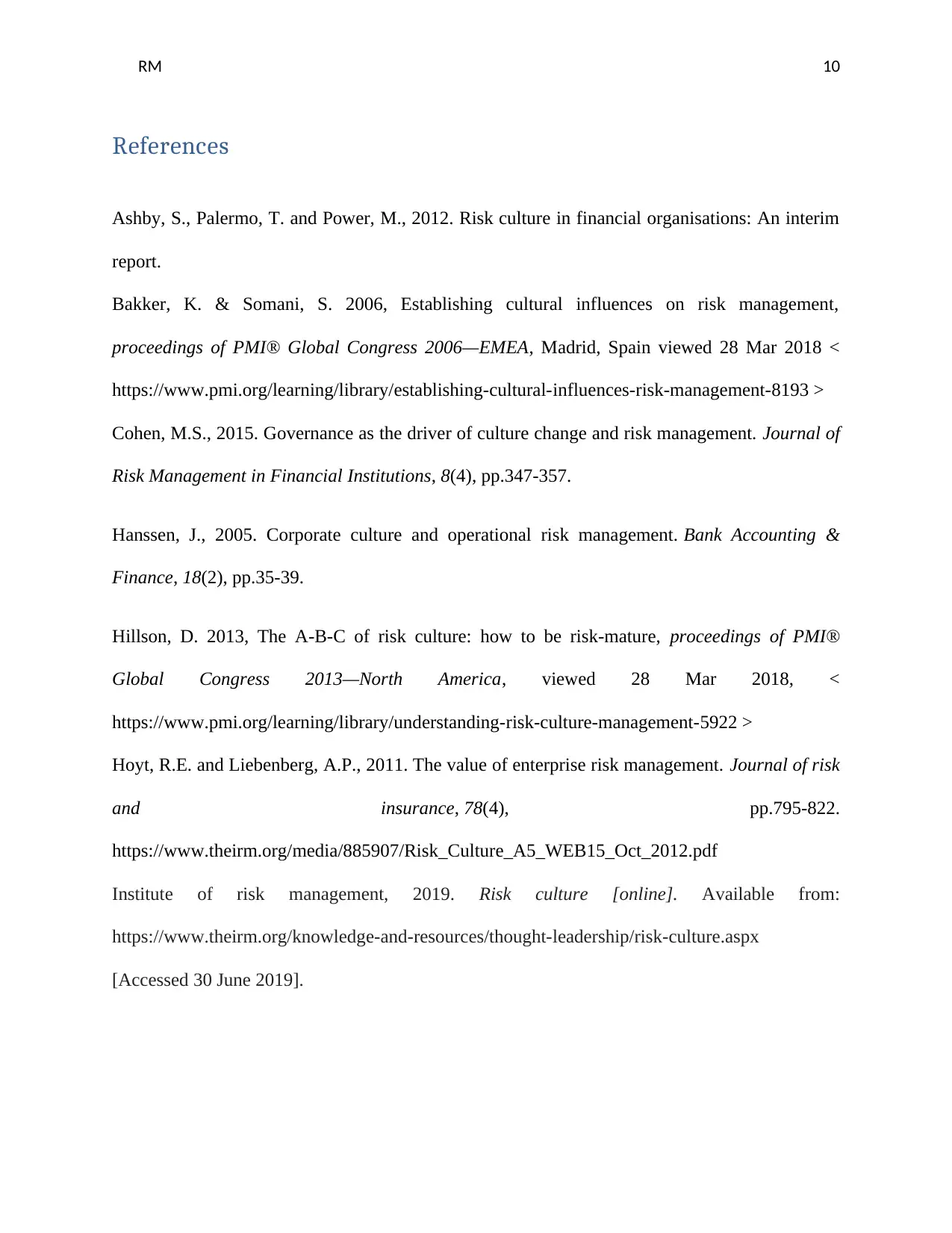
RM 10
References
Ashby, S., Palermo, T. and Power, M., 2012. Risk culture in financial organisations: An interim
report.
Bakker, K. & Somani, S. 2006, Establishing cultural influences on risk management,
proceedings of PMI® Global Congress 2006—EMEA, Madrid, Spain viewed 28 Mar 2018 <
https://www.pmi.org/learning/library/establishing-cultural-influences-risk-management-8193 >
Cohen, M.S., 2015. Governance as the driver of culture change and risk management. Journal of
Risk Management in Financial Institutions, 8(4), pp.347-357.
Hanssen, J., 2005. Corporate culture and operational risk management. Bank Accounting &
Finance, 18(2), pp.35-39.
Hillson, D. 2013, The A-B-C of risk culture: how to be risk-mature, proceedings of PMI®
Global Congress 2013—North America, viewed 28 Mar 2018, <
https://www.pmi.org/learning/library/understanding-risk-culture-management-5922 >
Hoyt, R.E. and Liebenberg, A.P., 2011. The value of enterprise risk management. Journal of risk
and insurance, 78(4), pp.795-822.
https://www.theirm.org/media/885907/Risk_Culture_A5_WEB15_Oct_2012.pdf
Institute of risk management, 2019. Risk culture [online]. Available from:
https://www.theirm.org/knowledge-and-resources/thought-leadership/risk-culture.aspx
[Accessed 30 June 2019].
References
Ashby, S., Palermo, T. and Power, M., 2012. Risk culture in financial organisations: An interim
report.
Bakker, K. & Somani, S. 2006, Establishing cultural influences on risk management,
proceedings of PMI® Global Congress 2006—EMEA, Madrid, Spain viewed 28 Mar 2018 <
https://www.pmi.org/learning/library/establishing-cultural-influences-risk-management-8193 >
Cohen, M.S., 2015. Governance as the driver of culture change and risk management. Journal of
Risk Management in Financial Institutions, 8(4), pp.347-357.
Hanssen, J., 2005. Corporate culture and operational risk management. Bank Accounting &
Finance, 18(2), pp.35-39.
Hillson, D. 2013, The A-B-C of risk culture: how to be risk-mature, proceedings of PMI®
Global Congress 2013—North America, viewed 28 Mar 2018, <
https://www.pmi.org/learning/library/understanding-risk-culture-management-5922 >
Hoyt, R.E. and Liebenberg, A.P., 2011. The value of enterprise risk management. Journal of risk
and insurance, 78(4), pp.795-822.
https://www.theirm.org/media/885907/Risk_Culture_A5_WEB15_Oct_2012.pdf
Institute of risk management, 2019. Risk culture [online]. Available from:
https://www.theirm.org/knowledge-and-resources/thought-leadership/risk-culture.aspx
[Accessed 30 June 2019].
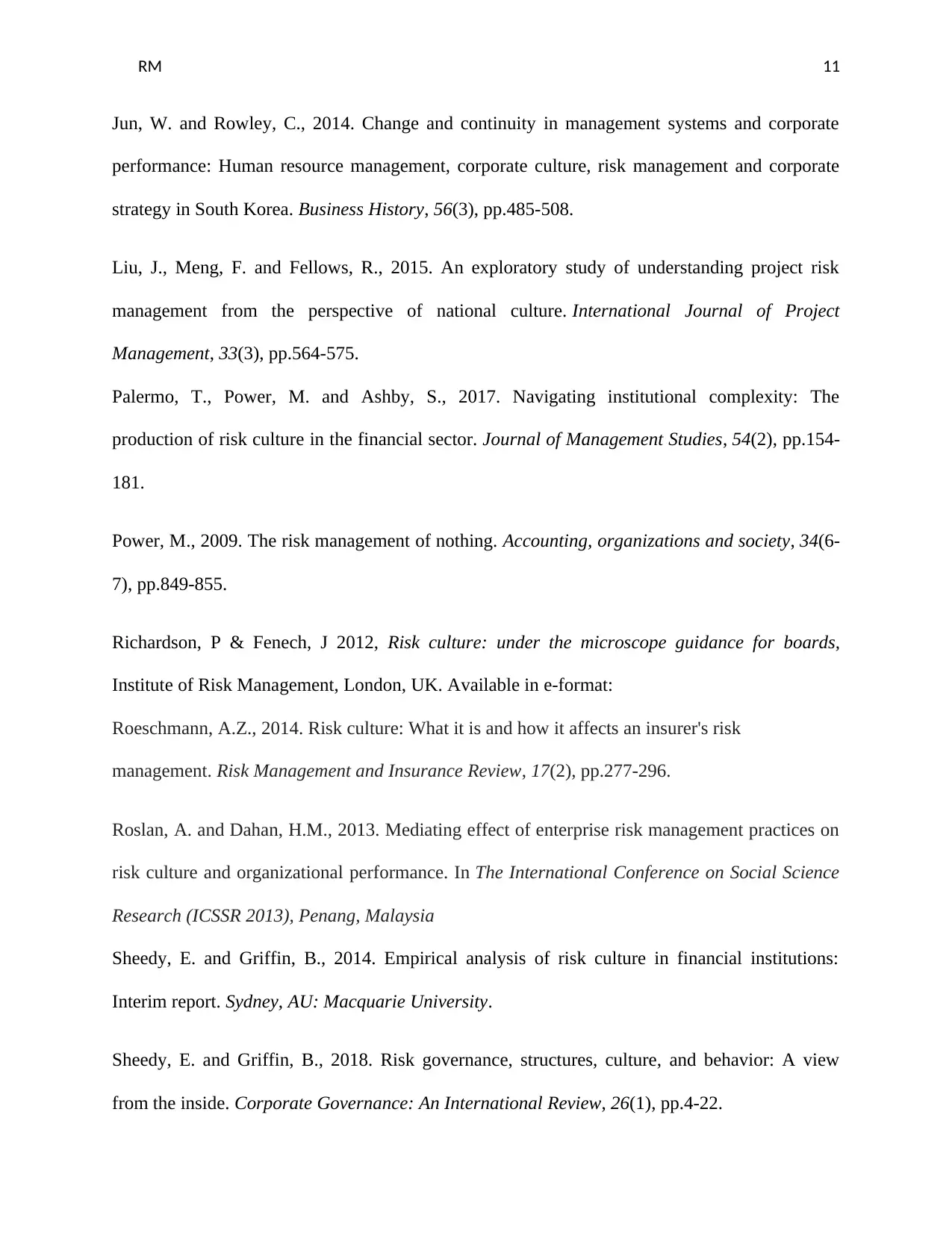
RM 11
Jun, W. and Rowley, C., 2014. Change and continuity in management systems and corporate
performance: Human resource management, corporate culture, risk management and corporate
strategy in South Korea. Business History, 56(3), pp.485-508.
Liu, J., Meng, F. and Fellows, R., 2015. An exploratory study of understanding project risk
management from the perspective of national culture. International Journal of Project
Management, 33(3), pp.564-575.
Palermo, T., Power, M. and Ashby, S., 2017. Navigating institutional complexity: The
production of risk culture in the financial sector. Journal of Management Studies, 54(2), pp.154-
181.
Power, M., 2009. The risk management of nothing. Accounting, organizations and society, 34(6-
7), pp.849-855.
Richardson, P & Fenech, J 2012, Risk culture: under the microscope guidance for boards,
Institute of Risk Management, London, UK. Available in e-format:
Roeschmann, A.Z., 2014. Risk culture: What it is and how it affects an insurer's risk
management. Risk Management and Insurance Review, 17(2), pp.277-296.
Roslan, A. and Dahan, H.M., 2013. Mediating effect of enterprise risk management practices on
risk culture and organizational performance. In The International Conference on Social Science
Research (ICSSR 2013), Penang, Malaysia
Sheedy, E. and Griffin, B., 2014. Empirical analysis of risk culture in financial institutions:
Interim report. Sydney, AU: Macquarie University.
Sheedy, E. and Griffin, B., 2018. Risk governance, structures, culture, and behavior: A view
from the inside. Corporate Governance: An International Review, 26(1), pp.4-22.
Jun, W. and Rowley, C., 2014. Change and continuity in management systems and corporate
performance: Human resource management, corporate culture, risk management and corporate
strategy in South Korea. Business History, 56(3), pp.485-508.
Liu, J., Meng, F. and Fellows, R., 2015. An exploratory study of understanding project risk
management from the perspective of national culture. International Journal of Project
Management, 33(3), pp.564-575.
Palermo, T., Power, M. and Ashby, S., 2017. Navigating institutional complexity: The
production of risk culture in the financial sector. Journal of Management Studies, 54(2), pp.154-
181.
Power, M., 2009. The risk management of nothing. Accounting, organizations and society, 34(6-
7), pp.849-855.
Richardson, P & Fenech, J 2012, Risk culture: under the microscope guidance for boards,
Institute of Risk Management, London, UK. Available in e-format:
Roeschmann, A.Z., 2014. Risk culture: What it is and how it affects an insurer's risk
management. Risk Management and Insurance Review, 17(2), pp.277-296.
Roslan, A. and Dahan, H.M., 2013. Mediating effect of enterprise risk management practices on
risk culture and organizational performance. In The International Conference on Social Science
Research (ICSSR 2013), Penang, Malaysia
Sheedy, E. and Griffin, B., 2014. Empirical analysis of risk culture in financial institutions:
Interim report. Sydney, AU: Macquarie University.
Sheedy, E. and Griffin, B., 2018. Risk governance, structures, culture, and behavior: A view
from the inside. Corporate Governance: An International Review, 26(1), pp.4-22.
⊘ This is a preview!⊘
Do you want full access?
Subscribe today to unlock all pages.

Trusted by 1+ million students worldwide
1 out of 13
Related Documents
Your All-in-One AI-Powered Toolkit for Academic Success.
+13062052269
info@desklib.com
Available 24*7 on WhatsApp / Email
![[object Object]](/_next/static/media/star-bottom.7253800d.svg)
Unlock your academic potential
Copyright © 2020–2025 A2Z Services. All Rights Reserved. Developed and managed by ZUCOL.





